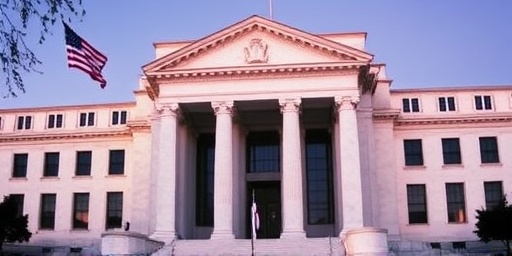In a pivotal move that sent shockwaves through financial markets, the US Federal Reserve has signaled a potential interest rate cut as early as December, driven by recent data showing inflation easing below the central bank’s target levels. This announcement comes at a time when economists have been closely monitoring economic indicators for signs of relief from persistent inflationary pressures, offering hope to consumers and businesses alike.
The Federal Reserve‘s latest policy statement, released following its two-day meeting, emphasized that inflation has moderated substantially over the past year, with core measures now trending closer to the 2% goal. Fed Chair Jerome Powell, in his post-meeting press conference, noted, ‘We are well on our way to achieving our inflation objective, and the risks of higher inflation have diminished.’ This rhetoric marks a shift from the hawkish stance the central bank has maintained since 2022, when aggressive interest rate hikes were implemented to combat soaring inflation rates that peaked above 9%.
Major stock indices surged in response, with the S&P 500 climbing 1.2% and the Dow Jones Industrial Average gaining over 400 points on the day of the announcement. Bond yields dipped, reflecting investor expectations of looser monetary policy ahead. This market rally underscores the high stakes involved in the Federal Reserve‘s decisions on interest rates, which influence everything from mortgage costs to corporate borrowing.
Fed’s Inflation Gauge Shows Steady Decline Toward 2% Target
The cornerstone of the Federal Reserve’s decision-making lies in its assessment of inflation trends. Recent data from the Consumer Price Index (CPI) indicated that headline inflation rose by just 2.4% year-over-year in October, down from 2.6% in September and a stark contrast to the double-digit spikes seen in 2022. Core inflation, which excludes volatile food and energy prices, stood at 3.3%, the lowest since early 2021. These figures suggest that the Federal Reserve’s stringent interest rate policy has successfully tamed the inflationary beast without tipping the economy into recession.
Economists attribute this cooling to several factors, including normalized supply chains post-pandemic, softer energy prices, and a labor market that remains robust but no longer overheated. Unemployment hovered at 4.1% in the latest report, with job growth averaging 150,000 per month over the past quarter. ‘The data is painting a picture of disinflation without distress,’ said Michelle Bowman, a Federal Reserve Governor, during the meeting. This balance is crucial, as the Fed aims to avoid the pitfalls of the 1970s stagflation era, where premature easing reignited price pressures.
Delving deeper, the Personal Consumption Expenditures (PCE) index, the Federal Reserve’s preferred inflation measure, showed a 2.1% annual increase in September, edging ever closer to the 2% target. Shelter costs, which have been a stubborn drag on disinflation, have begun to moderate, with rental growth slowing to 3.5% from over 7% two years ago. These granular improvements provide the Federal Reserve with the confidence to consider a rate cut, potentially lowering the federal funds rate from its current 5.25%-5.50% range.
However, officials remain cautious. The Summary of Economic Projections (SEP) updated during the meeting forecasted two rate cuts by the end of 2024, with inflation expected to hit 2.5% this year before reaching the target in 2025. This projection reflects the Fed’s data-dependent approach, where incoming reports on wages, consumer spending, and global events could sway the timeline.
Market Rally Ignites on Hopes of Imminent Rate Cut
The financial markets wasted no time in digesting the Federal Reserve’s dovish tilt. Equities led the charge, with technology stocks like Apple and Nvidia posting gains of 2% and 1.8%, respectively, as lower interest rates typically boost valuations for growth-oriented sectors. The Nasdaq Composite index rose 1.5%, buoyed by expectations that cheaper borrowing costs would accelerate innovation and investment in AI and semiconductors.
Bond traders also reacted swiftly, with the 10-year Treasury yield falling to 4.1% from 4.3% pre-announcement. This decline signals anticipation of a rate cut, as yields often move inversely to Fed policy expectations. Mortgage rates, which track the 10-year yield, dipped below 6.5% for the first time in months, providing a glimmer of relief for homebuyers who have been sidelined by elevated costs. ‘This is the spark the housing market needed,’ commented National Association of Realtors Chief Economist Lawrence Yun.
Currency markets saw the US dollar weaken against major peers, with the euro strengthening by 0.8%. This depreciation could benefit US exporters by making American goods more competitive abroad, a positive for multinational corporations. Cryptocurrencies, sensitive to interest rate environments, saw Bitcoin climb above $70,000, as investors bet on a risk-on mood persisting into year-end.
Yet, not all reactions were uniformly positive. Gold prices, often a hedge against uncertainty, held steady rather than surging, indicating that markets view the Federal Reserve’s path as predictable. Volatility indices like the VIX dropped to 15, their lowest in weeks, suggesting reduced fears of economic turbulence. Overall, the rally added over $1 trillion to market capitalization across major indices, highlighting the profound impact of Federal Reserve signals on investor sentiment.
Consumer and Business Impacts from Potential Lower Interest Rates
For everyday Americans, a Federal Reserve rate cut could translate into tangible relief. Credit card rates, which average 21% and are tied to the prime rate influenced by Fed actions, might ease by 0.25% or more with the first cut. This would save households billions in interest payments annually, especially for the 45% of cardholders carrying balances. Auto loans, another high-interest category, could see rates drop from 7.5% to around 7%, stimulating demand in a sector that has seen sales plateau at 15.5 million units yearly.
Businesses stand to gain even more. Corporate borrowing costs, elevated since the rate-hiking cycle began, have constrained capital expenditures. A rate cut would lower yields on investment-grade bonds, encouraging firms to invest in expansion. Small businesses, which rely on variable-rate loans, could see monthly payments decrease by hundreds of dollars, fostering job creation and innovation. ‘Lower rates are a lifeline for SMEs navigating post-pandemic recovery,’ stated US Chamber of Commerce President Suzanne Clark.
On the flip side, savers face headwinds. Yields on savings accounts and CDs, which peaked above 5%, may decline, eroding returns for retirees and conservative investors. The Federal Reserve must navigate this trade-off, ensuring that easing interest rates supports growth without reigniting inflation. Housing affordability remains a flashpoint; while lower rates could revive the market, supply shortages persist, with inventory at historic lows of 3.5 months’ supply.
Broader sectors like real estate investment trusts (REITs) and utilities, which are interest-rate sensitive, outperformed the broader market by 2-3% post-announcement. This sector rotation underscores how a rate cut reshapes economic priorities, shifting focus from inflation-fighting to growth stimulation.
Analysts Forecast Fed’s Rate Cut Timeline and Risks Ahead
Wall Street analysts are largely aligned with the Federal Reserve’s outlook, with 85% of economists in a Bloomberg survey predicting a December rate cut of 25 basis points. Firms like JPMorgan and Goldman Sachs have raised their forecasts for 2025 easing, now expecting three to four cuts total, bringing the fed funds rate to 4.00%-4.25%. ‘The data supports a pivot, but the Fed will wait for confirmation from November’s jobs report,’ advised JPMorgan Chief Economist Bruce Kasman.
Risks loom, however. Geopolitical tensions in the Middle East could spike oil prices, potentially reversing inflation gains. A hotter-than-expected labor market might prompt the Fed to hold rates steady, disappointing markets. Conversely, if consumer spending weakens—retail sales grew just 0.3% last month—earlier cuts could be on the table. The Federal Reserve’s dot plot, which illustrates policymakers’ views, showed a median expectation of 4.4% for the end-2025 rate, down from prior projections.
International implications are significant too. As the Federal Reserve eases, other central banks like the European Central Bank may follow suit, preventing currency wars. Emerging markets, burdened by dollar-denominated debt, could benefit from a softer dollar. Analysts at Moody’s Analytics warn that while a rate cut bolsters the US economy, over-easing risks asset bubbles, reminiscent of the pre-2008 era.
Looking ahead, key data releases including the November CPI on December 11 and the December FOMC meeting will be pivotal. Market-implied probabilities, via fed funds futures, now price in a 75% chance of a December cut, up from 50% pre-meeting. This anticipation will keep traders on edge, as the Federal Reserve’s next moves shape the trajectory of inflation, interest rates, and economic resilience.
As the year draws to a close, the Federal Reserve’s signaled rate cut positions the economy for a soft landing, with inflation on a downward path and growth projected at 2.1% for 2024. Investors and policymakers alike will monitor upcoming indicators closely, ready to adapt to whatever twists the data reveals. This evolving landscape promises continued volatility but also opportunities for recovery and expansion in the months ahead.









